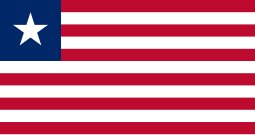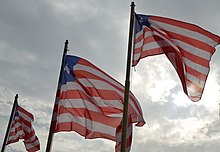It has been suggested that List of Liberian flags be merged into this article. (Discuss) Proposed since March 2024. |
 | |
| Use | National flag and ensign |
|---|---|
| Proportion | 10:19 |
| Adopted | 24 August 1847 |
| Design | Eleven horizontal stripes alternating red and white; in the canton, a white star on a blue field |
| Designed by | Susannah Elizabeth, Matilda Newport, Rachel Johnson, Mary Hunter, Sarah McGill Russwurm, Colonette Teage Ellis and Sara Draper |
 | |
| Use | Naval jack |


The flag of Liberia, occasionally referred to as the Lone Star,[1][2] bears a close resemblance to the flag of the United States, representing Liberia's founding by former black slaves from the United States and the Caribbean.[3] They are both part of the stars and stripes flag family.
The Liberian flag has similar red and white stripes, as well as a blue square with a white star in the canton. It was adopted on 24 August 1847.[4][5]
- ^ Cite error: The named reference
allafricawas invoked but never defined (see the help page). - ^ Rozario, Paul (2003). Liberia. Gareth Stevens. p. 5. ISBN 9780836823660.
- ^ "Background on conflict in Liberia". Archived from the original on 5 November 2007.
Paul Cuffee advocated settling formerly enslaved African Americans in Africa. He gained support from free black leaders in the US, and members of Congress for an early emigration plan. From 1815 to 1816, he financed and captained a successful voyage to British-ruled Sierra Leone, where he helped a small group of African-American immigrants establish themselves. Cuffee believed that African-Americans could more easily "rise to be a people" in Africa than in the US, where slavery and legislated limits on black freedom were still in place. Although Cuffee died in 1817, his early efforts to help repatriate African-Americans encouraged some free blacks and the American Colonization Society (ACS) to lead further settlements. Some free blacks in the Upper South created independent institutions dedicated to the idea of repatriation to Africa. The ACS was made up mostly of Friends (often called Quakers) and slaveholders, who disagreed on the issue of slavery but found common ground in support of repatriation. Friends opposed slavery but believed blacks would face better chances for freedom in Africa than in the US. The White Americans slaveholders opposed freedom for blacks but saw repatriation as a way of avoiding rebellions
- ^ Liberia: Open Door to Travel and Investment. Liberia. Department of Information and Cultural Affairs. 1967. p. 19.
This symbol of Negro liberty was first unfurled on August 24, 1847
- ^ "Liberia Flag and Description". 24 February 2021.